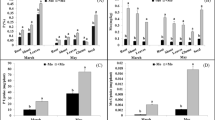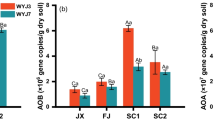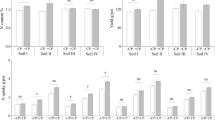Abstract
Molybdenum (Mo), an essential microelement for plants, animals, and microorganisms, is reported can reduce soil nitrogen (N) residues and regulate plant root growth, but little is known about its effect on soil N transformation in plant-root region. A specially designed rhizobox was used in the present study to investigate the N processes in rhizosphere and non-rhizosphere soils of winter wheat applied with different rates of Mo fertilizer. (1) In the rhizosphere soil, pH values increased with increasing rates of Mo application, nitrate (NO3−-N) accumulated at the rates of 0.15 and 0.3 mg Mo kg−1, potential denitrification activity (PDA) was significantly reduced by application of 0.15–1 mg Mo kg−1, and the copy numbers of narG and nosZ genes were increased by application of 0.15–1 mg Mo kg−1. (2) In the non-rhizosphere soil, NO3−-N content decreased by application of 0.15–0.3 mg Mo kg−1, and narG gene abundance increased obviously by application of 0.3–1 mg Mo kg−1. (3) Soil pH, NO3−-N, apparent nitrification rate (ANR), and nosZ gene abundance were significantly higher in rhizosphere than in non-rhizosphere soil. On the contrary, NH4+-N and total N, PDA, the abundance of AOB, and nirK and nirS genes were significantly higher in non-rhizosphere soil. The results indicated that the N transformations in rhizosphere and non-rhizosphere soils were differently affected by soil application of Mo fertilizer, and rhizosphere played a more important role in soil N cycle processes. The regulatory effects of Mo on these processes were to increase plant biomass and N uptake, promote the NO3−-N accumulation in rhizosphere soil, and weaken the denitrification in both rhizosphere and non-rhizosphere soils.





Similar content being viewed by others
Abbreviations
- Mo:
-
Molybdenum
- N:
-
Nitrogen
- PDA:
-
Potential denitrification activity
- ANR:
-
Apparent nitrification rate
- MBN:
-
Microbial biomass nitrogen
- SOM:
-
Soil organic matter
- TN:
-
Soil total nitrogen
References
Aimek M, Jísova L, Hopkins D (2002) What is the so-called optimum pH for denitrification in soil. Soil Biol Biochem 34(9):1227–1234. https://doi.org/10.1016/S0038-0717(02)00059-7
Akiyama H, Tsuruta H, Watanabe T (2000) N2O and NO emissions from soils after the application of different chemical fertilizers. Chemosphere Global Change Sci 2(3):313–320. https://doi.org/10.1016/S1465-9972(00)00010-6
Arth I, Frenzel P (2000) Nitrification and denitrification in the rhizosphere of rice: the detection of processes by a new multi-channel electrode. Biol Fertil Soils 31(5):427–435
Bao SD (2002) Soil and agricultural chemistry analysis, 3rd edn. China Agriculture Press, Beijing
Bao J, Shi M, Zhang M, Liang D, Wu X (2011) Nitrification of main soils in China and its relationship with soil properties. Sci Agric Sin 44(7):1390–1398 (in Chinese with English abstract)
Barron AR, Wurzburger N, Bellenger JP, Wright SJ, Kraepiel AML, Hedin LO (2009) Molybdenum limitation of asymbiotic nitrogen fixation in tropical forest soils. Nat Geosci 2(1):42–45. https://doi.org/10.1038/ngeo366
Bravin MN, Garnier C, Lenoble V, Gérard F, Dudal Y, Hinsinger P (2012) Root-induced changes in pH and dissolved organic matter binding capacity affect copper dynamic speciation in the rhizosphere. Geochim Cosmochim Acta 84:256–268. https://doi.org/10.1016/j.gca.2012.01.031
Cassman KG, Dobermann A, Walters DT (2002) Agroecosystems, nitrogen-use efficiency, and nitrogen management. AMBIO J Hum Environ 31(2):132–140. https://doi.org/10.1579/0044-7447-31.2.132
Chen Z (2010) Effects of long-term fertilization on denitrification and denitrifying microorganisms in paddy soil. PhD thesis, Institute of Subtropical Agriculture, Chinese Academy of Sciences, Changsha, China
Chen XP, Zhu YG, Xia Y, Shen JP (2008) Ammonia-oxidizing archaea: important players in paddy rhizosphere soil? Environ Microbiol 10(8):1978–1987. https://doi.org/10.1111/j.1462-2920.2008.01613.x
Dakora FD, Phillips DA (2002) Root exudates as mediators of mineral acquisition in low-nutrient environments. Plant Soil 245(1):35–47
Dancer WS, Peterson LA, Chesters G (1973) Ammonification and nitrification of N as influenced by soil pH and previous N treatments. Soil Sci Soc Am J 37(1):67–69. https://doi.org/10.2136/sssaj1973.03615995003700010024x
Delaune RD, Lindau CW, Sulaeman E, Jugsujinda A (1998) Nitrification and denitrification estimates in a Louisiana swamp forest soil as assessed by 15N isotope dilution and direct gaseous measurements. Water Air Soil Pollut 106:149–161. https://doi.org/10.1023/A:1004953626415
Di HJ, Cameron KC, Shen JP, Winefield CS, Callaghan M, Bowatte S, He JZ (2009) Nitrification driven by bacteria and not archaea in nitrogen-rich grassland soils. Nat Geosci 2:621–624. https://doi.org/10.1038/NGEO613
Fan XH, Lin DX, Shen M, Qin SW (2005) Characteristics of mineralization and nitrification in the calcareous soils from a long-term fertiliza experimental field. Acta Pedol Sin 42(2):340–343 (in Chinese with English abstract)
Fowler D, Coyle M, Skiba U, Sutton MA, Cape JN, Reis S, Sheppard LJ, Jenkins A, Grizzetti B, Galloway JN, Vitousek P, Leach A, Bouwman AF, Butterbach-Bahl K, Dentener F, Stevenson D, Amann M, Voss M (2013) The global nitrogen cycle in the twenty-first century. Philos Trans R Soc B 368(1621):20130164. https://doi.org/10.1098/rstb.2013.0164
Gazzarrini S, Lejay T, Gojon A, Ninnemann O, Frommer WB, von Wiren N (1999) Three functional transporters for constitutive, diurnally regulated, and starvation-induced uptake of ammonium into Arabidopsis roots. Plant Cell 11:937–947. https://doi.org/10.1105/tpc.11.5.937
Gessler A, Schneider S, Von Sengbusch D, Weber P, Hanemann U (1998) Field and laboratory experiments on net uptake of nitrate and ammonium by the roots of spruce (Picea abies) and beech (Fagus sylvatica) trees. New Phytol 138:275–285. https://doi.org/10.1046/j.1469-8137.1998.00107.x
Gregory PJ, Crawford DV, McGowan M (1979) Nutrient relations of winter wheat: 2. Movement of nutrients to the root and their uptake. J Agric Sci 93(2):495–504. https://doi.org/10.1017/S0021859600038193
Hall GH (1982) Apparent and measured rates of nitrification in the hypolimnion of a mesotrophic lake. Appl Environ Microbiol 43(3):542–547
Hamilton EW, Frank DA (2001) Can plants stimulate soil microbes and their own nutrient supply? Evidence from a grazing tolerant grass. Ecology 82:2397–2402. https://doi.org/10.1890/0012-9658(2001)082[2397:CPSSMA]2.0.CO;2
Hawkesford MJ (2014) Reducing the reliance on nitrogen fertilizer for wheat production. J Cereal Sci 59(3):276–283. https://doi.org/10.1016/j.jcs.2013.12.001
He Y, Xu J, Tang C, Wu Y (2005) Facilitation of pentachlorophenol degradation in the rhizosphere of ryegrass (Lolium perenne L.). Soil Biol Biochem 37:2017–2024. https://doi.org/10.1016/j.soilbio.2005.03.002
Henry S, Baudoin E, Lopez-Gutierrez JC, Martin-Laurent F, Baumann A, Philippot L (2004) Quantification of denitrifying bacteria in soils by nirK gene targeted real-time PCR. J Microbiol Methods 59:327–335. https://doi.org/10.1016/j.mimet.2004.07.002
Herman DJ, Johnson KK, Jaeger CH, Schwartz E, Firestone MK (2006) Root influence on nitrogen mineralization and nitrification in rhizosphere soil. Soil Sci Soc Am J 70(5):1504–1511. https://doi.org/10.2136/sssaj2005.0113
Hu C, Wang Y, Wei W (2002) Effect of molybdenum applications on concentrations of free amino acids in winter wheat at different growth stages. J Plant Nutr 25(7):1487–1499. https://doi.org/10.1081/PLN-120005404
Huang G, Huang Y, Hu H, Liu F, Zhang Y, Deng R (2015) Remediation of nitrate–nitrogen contaminated groundwater using a pilot-scale two-layer heterotrophic–autotrophic denitrification permeable reactive barrier with spongy iron/pine bark. Chemosphere 130:8–16. https://doi.org/10.1016/j.chemosphere.2015.02.029
Ishii S, Ikeda S, Minamisawa K, Senoo K (2011) Nitrogen cycling in rice paddy environments: past achievements and future challenges. Microbes Environ 26:282–292. https://doi.org/10.1264/jsme2.ME11293
Jackson LE, Burger M, Cavagnaro TR (2008) Roots, nitrogen transformations, and ecosystem services. Annu Rev Plant Biol 59:341–363. https://doi.org/10.1146/annurev.arplant.59.032607.092932
Jauregui MA, Reisenauer HM (1982) Dissolution of oxides of manganese and iron by root exudate components. Soil Sci Soc Am J 46(2):314–317. https://doi.org/10.2136/sssaj1982.03615995004600020020x
Joergensen RG, Brookes PC (1990) Ninhydrin-reactive nitrogen measurements of microbial biomass in 0.5 m K2SO4 soil extracts. Soil Biol Biochem 22(8):1023–1027. https://doi.org/10.1016/0038-0717(90)90027-W
Leininger S, Urich T, Schloter M, Schwark L, Qi J, Nicol GW, Prosser JI, Schuster SC, Schleper C (2006) Archaea predominate among ammonia-oxidizing prokaryotes in soils. Nature 442(7104):806–809. https://doi.org/10.1038/nature04983
Lin S (2011) The study on N2O flux from different land uses in Three Gorges Reservoir Area. PhD thesis, Huazhong agricultural University, Wuhan, China
Liu HE, (2009) Study on interaction of molybdenum and phosphorus and its mechanism of Brassica Napus. PhD thesis. Huazhong agricultural University, Wuhan, China
Liu JB, Hou HJ, Sheng R, Chen Z, Zhu YJ, Qin HL, Wei WX (2012) Denitrifying communities differentially respond to flooding drying cycles in paddy soils. Appl Soil Ecol 62:155–162. https://doi.org/10.1016/j.apsoil.2012.06.010
Liu X, Zhang Y, Han W, Tang A, Shen J, Cui Z, Vitousek P, Erisman JW, Goulding K, Christie P, Fangmeier A, Zhang F (2013) Enhanced nitrogen deposition over China. Nature 494(7438):459–462. https://doi.org/10.1038/nature11917
Mørkved PT, Dörsch P, Bakken LR (2007) The N2O product ratio of nitrification and its dependence on long-term changes in soil pH. Soil Biol Biochem 39(8):2048–2057. https://doi.org/10.1016/j.soilbio.2007.03.006
Nie ZJ (2014) Differences in molybdenum uptake, utilization and its regulation mechanism between two winter wheat cultivars. PhD thesis. Huazhong agricultural University, Wuhan, China
Palmer K, Drake HL, Horn MA (2010) Association of novel and highly diverse acid-tolerant denitrifiers with N2O fluxes of an acidic fen. Appl Environ Microbiol 76:1125–1134. https://doi.org/10.1128/AEM.02256-09
Pastor J, Aber JD, McClaugherty CA, Melillo JM (1984) Above ground production and N and P cycling along a nitrogen mineralization gradient on Blackhawk Island, Wisconsin. Ecology 65(1):256–268. https://doi.org/10.2307/1939478
Pell M, Stenberg B, Stenström J, Torstensson L (1996) Potential denitrification activity assay in soil—with or without chloramphenicol? Soil Biol Biochem 28(3):393–398. https://doi.org/10.1016/0038-0717(95)00149-2
Rakshit A, Singh HB, Sen A (2015) Nutrient use efficiency: from basics to advances. Springer (India) Private Limited, New Delhi
Rao PSC, Jessup RE, Reddy KR (1984) Simulation of nitrogen dynamics in flooded soils. Soil Sci 138:54–62
Raven JA, Edwards D (2001) Roots: evolutionary origins and biogeochemical significance. J Exp Bot 52:381–401. https://doi.org/10.1093/jexbot/52.suppl_1.381
Romain B, Leadley PW, Hungate BA (2005) Global change, nitrification, and denitrification: a review. Glob Biogeochem Cycles 19:341–356
Rose TJ, Hardiputra B, Rengel Z (2010) Wheat, canola and grain legume access to soil phosphorus fractions differs in soils with contrasting phosphorus dynamics. Plant Soil 326(1–2):159–170. https://doi.org/10.1007/s11104-009-9990-4
Rotthauwe JH, Witzel KP, Liesack W (1997) The ammonia monooxygenase structural gene amoa as a functional marker: molecular fine-scale analysis of natural ammonia-oxidizing populations. Appl Environ Microbiol 63(12):4704–4712
Rudisill MA, Turco RF, Hoagland LA (2016) Fertility practices and rhizosphere effects alter ammonia oxidizer community structure and potential nitrification activity in pepper production soils. Appl Soil Ecol 99:70–77. https://doi.org/10.1016/j.apsoil.2015.10.011
Sabey BR (1969) Influence of soil moisture tension on nitrate accumulation in soils. Soil Sci Soc Am J 33(2):263–266. https://doi.org/10.2136/sssaj1969.03615995003300020027x
Sahan E, Muyzer G (2008) Diversity and spatio-temporal distribution of ammonia-oxidizing archaea and bacteria in sediments of the westerschelde estuary. FEMS Microbiol Ecol 64(2):175–186. https://doi.org/10.1111/j.1574-6941.2008.00462.x
Savci S (2012) An agricultural pollutant: chemical fertilizer. Int J Environ Sci Dev 3(1):73–80. https://doi.org/10.7763/IJESD.2012.V3.191
Silberbush M, Barber SA (1983) Sensitivity analysis of parameters used in simulating K-uptake with a mechanistic mathematical-model. Agron J 75(6):851–854. https://doi.org/10.2134/agronj1983.00021962007500060002x
Smith MS, Tiedje JM (1979) The effect of roots on soil denitrification. Soil Sci Soc Am J 43(5):951–955. https://doi.org/10.2136/sssaj1979.03615995004300050027x
Smith KA, Ball T, Conen F, Dobbie KE, Massheder J, Rey A (2003) Exchange of greenhouse gases between soil and atmosphere: interactions of soil physical factors and biological processes. Eur J Soil Sci 54(4):779–791. https://doi.org/10.1046/j.1351-0754.2003.0567.x
Sommers LE, Lindsay WL (1979) Effect of pH and Redox on predicted heavy metal-chelate equilibria in soils. Soil Sci Soc Am J 43(1):39–47. https://doi.org/10.2136/sssaj1979.03615995004300010007x
Sönmez NK, Sari M (2007) Monitoring land use change in the west Mediterranean region of Turkey: a case study on Antalya-Turkey coast. Fresenius Environ Bull 16(11):1325–1330
Ste-Marie C, Paré D (1999) Soil, pH and N availability effects on net nitrification in the forest floors of a range of boreal forest stands. Soil Biol Biochem 31(11):1579–1589. https://doi.org/10.1016/S0038-0717(99)00086-3
Sun XC, Hu CX, Tan QL (2006) Effects of molybdenum on antioxidative defense system and membrane lipid peroxidation in winter wheat under low temperature stress. J Plant Physiol Mol Biol 32(2):175–182 (in Chinese with English abstract)
Sun XC, Hu CX, Tan QL, Liu JS, Liu HE (2009) Effects of molybdenum on cold-responsive genes in abscisic acid (ABA)-dependent and ABA-independent pathways in winter wheat under low temperature stress. Ann Bot 104:345–356. https://doi.org/10.1093/aob/mcp133
Throbäck IN, Enwall K, Jarvis A, Hallin S (2004) Reassessing PCR primers targeting nirS, nirK and nosZ genes for community surveys of denitrifying bacteria with DGGE. FEMS Microbiol Ecol 49(3):401–417. https://doi.org/10.1016/j.femsec.2004.04.011
Uchida R (2000) Essential nutrients for plant growth: nutrient functions and deficiency symptoms. In: Plant nutrient management in Hawaii’s soils. University of Hawaii, Honolulu, pp 31–55
Wang F, Li J, Wang X, Zhang W, Zou B, Neher DA, Li Z (2014) Nitrogen and phosphorus addition impact soil N2O emission in a secondary tropical forest of South China. Sci Rep 4:5615. https://doi.org/10.1038/srep05615
Wang P, Di HJ, Cameron KC, Tan Q, Podolyan A, Zhao X, McLaren RG, Hu C (2017) The response of ammonia-oxidizing microorganisms to trace metals and urine in two grassland soils in New Zealand. Environ Sci Pollut Res 24(3):2476–2483. https://doi.org/10.1007/s11356-016-8030-1
Wen X, Hu CX, Sun XC, Zhao XH, Tan QL, Liu PJ, Xin J, Qin SY, Wang PC (2018) Characterization of vegetable nitrogen uptake and soil nitrogen transformation in response to continuous molybdenum application. J Plant Nutr Soil Sci 181(2):1–12. https://doi.org/10.1002/jpln.201700556
Weng B, Xie X, Yang J, Liu JC, Lu HL, Yan CL (2013) Research on the nitrogen cycle in rhizosphere of Kandelia obovata under ammonium and nitrate addition. Mar Pollut Bull 76(1):227–240. https://doi.org/10.1016/j.marpolbul.2013.08.034
Wichard T, Mishra B, Myneni SCB, Bellenger JP, Kraepiel AML (2009) Storage and bioavailability of molybdenum in soils increased by organic matter complexation. Nat Geosci 2(9):625–629. https://doi.org/10.1038/ngeo589
Wu SW, Hu CX, Tan QL, Nie ZJ, Sun XC (2014) Effects of molybdenum on water utilization, antioxidative defense system and osmotic-adjustment ability in winter wheat (Triticum aestivum) under drought stress. Plant Physiol Biochem 83:365–374. https://doi.org/10.1016/j.plaphy.2014.08.022
Yang O, Norton JM, Stark JM (2017) Ammonium availability and temperature control contributions of ammonia oxidizing bacteria and archaea to nitrification in an agricultural soil. Soil Biol Biochem 113:161–172. https://doi.org/10.1016/j.soilbio.2017.06.010
Yu M, Hu CX, Wang YH (2002) Molybdenum efficiency in winter wheat cultivars as related to molybdenum uptake and distribution. Plant Soil 245:287–293. https://doi.org/10.1023/A:1020497728331
Zhang F, Römheld V, Marschner H (1989) Effect of zinc deficiency in wheat on the release of zinc and iron mobilizing root exudates. J Plant Nutr Soil Sci 152(2):205–210. https://doi.org/10.1002/jpln.19891520211
Zhang LM, Offre PR, He JZ, Verhamme DT, Nicol GW, Prosser JI (2010) Autotrophic ammonia oxidation by soil thaumarchaea. Proc Natl Acad Sci 107(40):17240–17245. https://doi.org/10.1073/pnas.1004947107
Zhang LM, Hu HW, Shen JP, He JZ (2012) Ammonia-oxidizing archaea have more important role than ammonia-oxidizing bacteria in ammonia oxidation of strongly acidic soils. ISME J 6(5):1032–1045. https://doi.org/10.1038/ismej.2011.168
Zhang Z, Zhang W, Yang H, Sheng R, Wei W, Qin H (2017) Elevated N2O emission by the rice roots: based on the abundances of narG and bacterial amoA genes. Environ Sci Pollut Res 24(2):2116–2125. https://doi.org/10.1007/s11356-016-7993-2
Acknowledgments
We would like to thank Prof. Jianming Xue, Prof. Ron McLaren, and Dr. Lei Zhong for the help on this manuscript.
Funding
The study was financially supported by the National Key Research and Development Program of China (2016YFD0200108) and Fundamental Research Funds for the Central Universities (2010PY025).
Author information
Authors and Affiliations
Corresponding author
Additional information
Responsible editor: Yi-ping Chen
Electronic supplementary material
Rights and permissions
About this article
Cite this article
Wen, X., Hu, C., Sun, X. et al. Research on the nitrogen transformation in rhizosphere of winter wheat (Triticum aestivum) under molybdenum addition. Environ Sci Pollut Res 26, 2363–2374 (2019). https://doi.org/10.1007/s11356-018-3565-y
Received:
Accepted:
Published:
Issue Date:
DOI: https://doi.org/10.1007/s11356-018-3565-y




